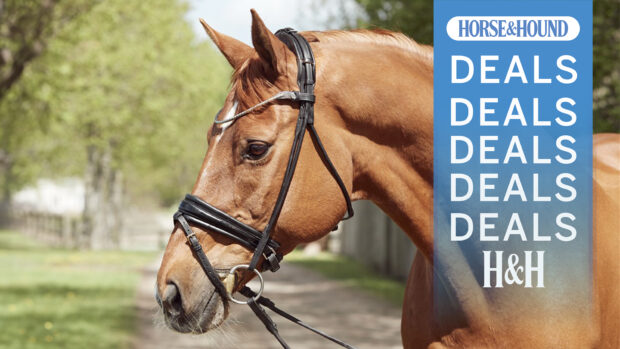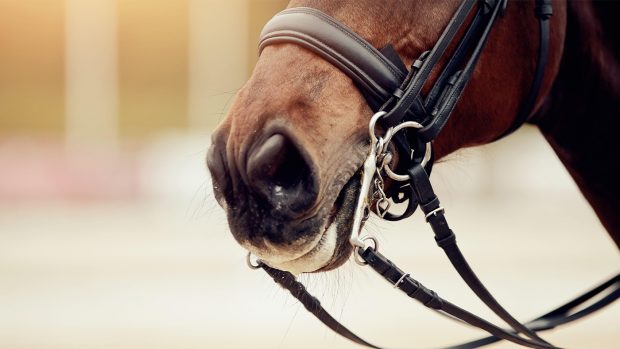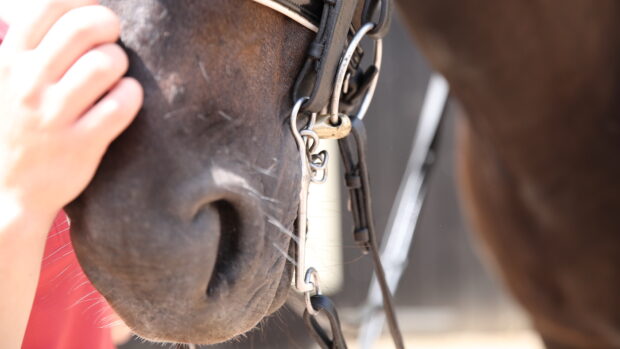In the right hands, the double bridle is a powerful and versatile tool which gives the rider a huge range of options to refine the rein aids, but in order to achieve this the rider needs to fully understand how to ride in a double bridle, which includes how to hold double bridle reins.
After all, as dressage legend Kyra Kyrklund points out: “A knife and fork are useful for eating, but put them in an ape’s hands, and they can be dangerous.”
Caroline Moore, FBHS and British Eventing youth performance coach, shares Kyra’s concern: “It’s an effective tool in the right hands, but it’s often seen in the wrong hands. If the curb rein is used too abruptly and with too sharp an action, it can seriously bruise the horse’s jaw and cause all sorts of back issues from the horse hollowing away from the action.”
Both experts warn against using the double bridle for the wrong reasons.
Caroline says: “In the eventing world, people sometimes go to the double bridle when they feel the horse is too strong or they can’t keep him connected, but you should not use it to manufacture submission. The horse has to be properly through and connected, working over the back, with the correct understanding of submission so he yields to the aids effectively in a snaffle.”
Kyra is equally adamant: “It is a tool for collected work. You should not use the double bridle to get the horse on the bit. If a horse is strong because he is on the forehand, a double bridle is not the answer. Many people use the double bridle before they have educated themselves or the horse. Jump the basic steps here and, sooner or later, that will become a problem. The right time to use a double bridle is with the more collected work when you are at medium level – for the flying changes and half-passes – to give you a more refined influence on the horse.”
How to ride in a double bridle: the basics
Caroline says: “Part of the problem is that some riders don’t know how to use the rein aid properly in the first place. You have to understand the basics; it is about pressure and release – at the right times.
“I usually start riders off with two reins on a pelham, so they learn to control each rein without having the effect of the double bridle. It is one way of teaching someone to use two sets of reins.”
In the same vein, Kyra gives her horses time to become used to the double bridle: “I don’t just put it on one day and start teaching the horse something new. You do work the horse finds easy and sometimes you have to hack them in it.”
Understanding the effect of the double bridle on the horse is equally fundamental.
Caroline explains: “You need to understand the action the bits have. The bridoon raises the horse’s head. It sits in the corner of the mouth. You use it as you do a snaffle.
“The curb has an effect on the horse when the shank moves to an approximately 45-degree angle, the curb chain goes into the chin groove and the horse yields by taking his nose in. It also puts pressure on the poll and the horse reacts by lowering his poll to avoid the pressure.”
How to hold double bridle reins
If you look back through history, you discover there are many different ways of how to hold double bridle reins, from the crossed, traditional two-and-two method; uncrossed two-and-two; the three-and-one and Fillis, to name but a few.
Caroline uses and teaches the most common, the traditional crossed method whereby the left curb and bridoon reins are held in the left hand, and the right curb and bridoon reins in the right hand. The curb rein is held between the little finger and the ring finger, the bridoon is held underneath the little finger. The curb and bridoon reins cross over, hence the name.
She says: “As you ride with your thumb on top of the reins pointing towards the horse’s ears, this method allows you to put more pressure on the bridoon easily as it is the lower rein. I also find it easier to shorten the bridoon rein this way without affecting the curb.”
Kyra started out with the crossed method, but learnt a version of the uncrossed two-and-two from dressage master Herbert Rehbein: “He always kept the curb rein under the little finger, then two fingers up, the bridoon rein, the reins in parallel. I want to be able to influence with each rein independently on one side or the other. You can have one or two fingers in between, depending on how much of a difference in influence you want to have.
The “Fillis” hold is named after the British-born French riding master James Fillis, who rode with the bridoon rein on top of the hand. It causes the correct rein to engage automatically. When the horse’s head goes up, the curb gets naturally stronger, and when the horse is too low, the bridoon engages and naturally gets stronger. The rider doesn’t need to do anything to get the desired effect.
Kyra also uses the “three-and-one, when I have one bridoon rein on its own in one hand and the remaining three reins in the other hand [usually the left],” she explains. “It all depends on the horse you are working with.”
For this hold, the correct placement of reins in the left hand is to hold the left snaffle on the outside of the little finger, the left curb rein between little finger and ring finger, and the right curb rein between the ring and middle fingers. The right hand holds the right snaffle rein in the traditional position between the right little finger and ring finger.
Checking your double bridle is the right fit
Making sure the horse is comfortable in his double bridle is also critical, and Caroline says: “The most important thing is that the angle of the curb shank is no more than 45 degrees. Often you see an amateur working a horse with a curb shank that is horizontal.”
Kyra explains this is down to the curb chain not being tightened correctly: “If the curb chain is too loose, then you can pull the curb through more. This can result in the port turning up. Some horses don’t like the port moving too much in their mouth.
“The bits you choose all depend on the conformation of your horse’s mouth. If you have a bit with a high port and a horse with a shallow mouth, then the port may touch the roof of his mouth. If you use a curb bit that is too wide, it may move too much sideways in his mouth, and the curb section can end up on the bar of his mouth. If the horse has a small mouth, then you must not use a heavy curb bit.
“My horse Matador had a sensitive mouth, so I swapped the bridoon bit for a snaffle. This is fine, as long as the snaffle ring size complies with the rules. He also had a straight, but thin curb, which I hardly ever used, so he didn’t have too much in his mouth.”
Using a double bridle makes all the difference to Caroline’s eventer Allstar B, ridden by Ros Canter: “He is a notoriously idle horse and energy has to be created massively. You maintain that energy through the contact. We often only use the double bridle the day before and on the morning of the dressage test as it creates a light, fresh feeling; you might not get that degree of cadence without using a double bridle.”
Top tips when learning how to use a double bridle
- Use a pelham or a snaffle with two sets of reins to get used to riding with double reins. Learn to become adept at shortening and lengthening them independently of each other to help you learn how to hold double bridle reins.
- Ask for advice – trainer, friends, saddler, bit-fitting consultant – to ensure the bits, bridle and curb chain fit correctly. Finding the right bits is not always straightforward and can takes some trial and error.
- Give your horse time to get used to having two bits in his mouth. Start off using it with work he finds easy.
- Make sure your horse doesn’t associate the double bridle with being asked for something he finds difficult or unpleasant. Sometimes, it helps to take him for a hack in his double bridle.
You might also be interested in:

9 smart double bridles you can order today

8 bridles with flash nosebands that you might like in your tack room

Subscribe to Horse & Hound magazine today – and enjoy unlimited website access all year round
Horse & Hound magazine, out every Thursday, is packed with all the latest news and reports, as well as interviews, specials, nostalgia, vet and training advice. Find how you can enjoy the magazine delivered to your door every week, plus options to upgrade your subscription to access our online service that brings you breaking news and reports as well as other benefits.



